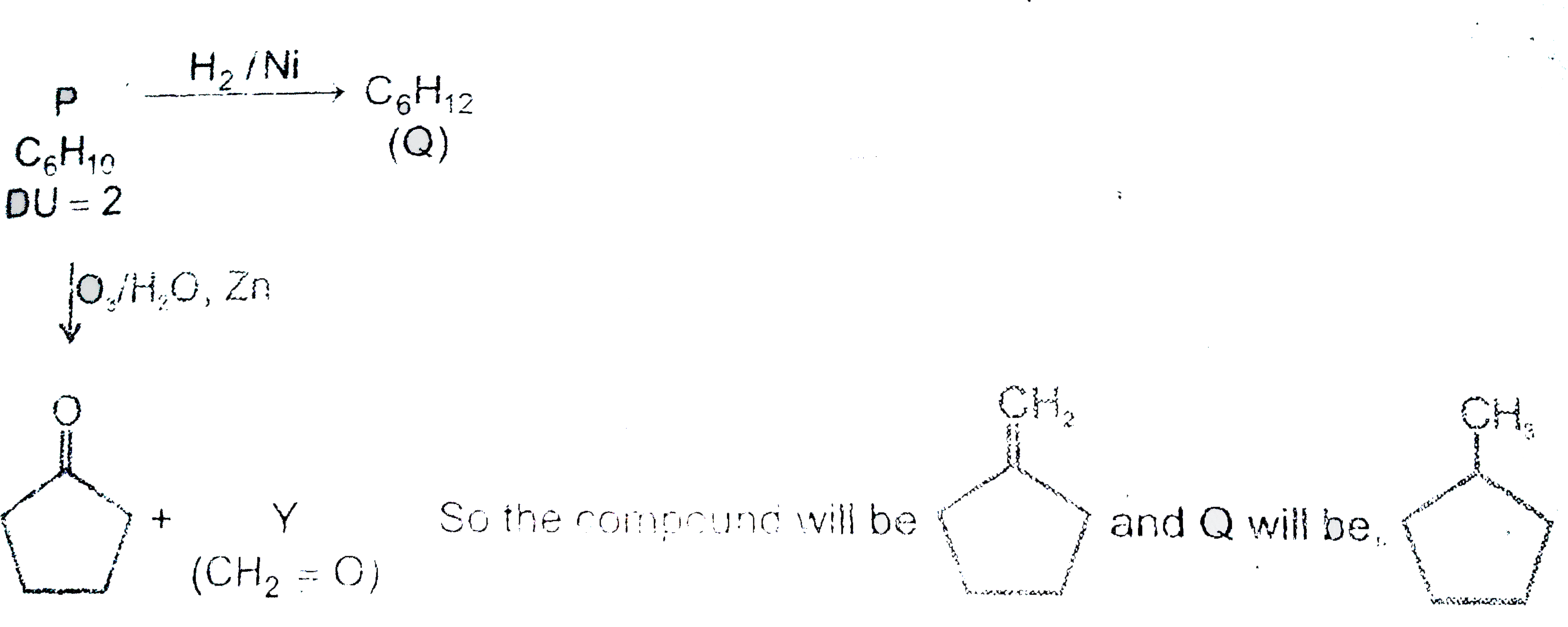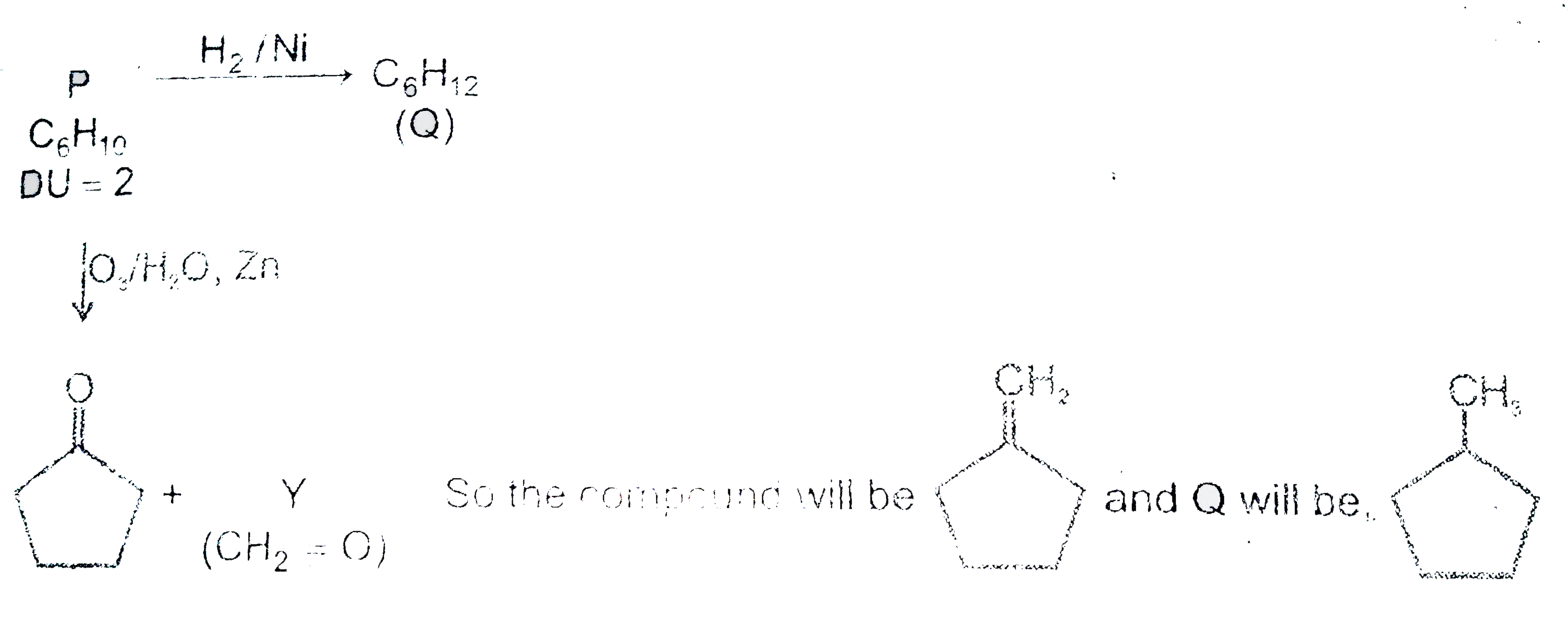InterviewSolution
This section includes InterviewSolutions, each offering curated multiple-choice questions to sharpen your knowledge and support exam preparation. Choose a topic below to get started.
| 90351. |
A compound 'X' (C_(14)H_(14)O) on mild oxidation yields C_(14)H_(12)(Y). If X is treated with a dehydratingg agent, it loses a molecule of H_(2)O and resulting product on vigoporus oxidation yields two molecule of benzoic acid. Identify the structure of X and Y. |
|
Answer»
|
|
| 90352. |
A compound with nitro group was reduced by Sn//HCl, followed by treatment with NaNO_(2)//HCl and followed by phenol. The chromophore group in the compound is |
|
Answer» `NO_(2)` GROUP 
|
|
| 90353. |
A compound with nitro group was reduced by Sn//HCl, followed by treatment with NaNO_(2)//HCl and followed by phenol. The chromophore group in the final compound is |
|
Answer» `NO_(2)` GROUP |
|
| 90354. |
A compound with molecular mass 180 is acylated with CH_(3)COCl to get a compound with molecular mass 390. the number of amio groups present per molecule of the former compound is |
|
Answer» 6 `-NH_(2)+CH_(3)COCl to -NHCOCH_(3)+HCl` In other words, acetylation of each `NH_(2)` group increases the mass by 43-1=42 amu. now since the mol. mass of the organic COMPOUND is 180 while that of the acetylated product is 390, therefore, increase in the mass DUE to acetylation=390-180=210amu. `therefore`No. of `-NH_(2)` groups`=(210)/(42)=5` |
|
| 90355. |
A compound with molecular mass 180 is acylated with CH_(3)COCl to get a compound with molecular mass 390. the number of amino groups present per molecules of the former compounds is |
|
Answer» 2 |
|
| 90356. |
A compound with molecular mass 180 is acylated with CH_(3)COCl to get a compound with molecular mass 390. the number of amino groups present per molecule of the former compound is |
|
Answer» 2 |
|
| 90357. |
A compound with molecular mass 180 is acylated with CH_3COCl to get a compound with molecular mass 390. The number of amino groups present per molecule of the former compound is : |
|
Answer» 2 Now since the molecular mass increases by 42 unit as a result of the reaction of ONE MOLE of `CH_3COCl` with one- `NH_2` GROUP and the given increase in mass is 210. Hence the number of-`NH_2`groups is= 210/42 = 5. |
|
| 90358. |
A compound with molecular mass 180 is acylated with CH_(3)COCl to get a compound with molecular mass 390. The number of amino groups present per molecule of the former compound is : |
|
Answer» 6 |
|
| 90359. |
A compoundwith molecular mass 162is acylated withCH_3COClto get a compoundwith molecular mass 456 The number of aminogroupspresenter molecule of the formercompoundsis : |
|
Answer» |
|
| 90360. |
A compound with molecular formula C_(8)H_(18)O_(4) does not give litmus test and does not give coloue with 2,4-DNP. Ir reacts with excess MeCOCL to give a compound whose vapour density is 131. Compound A contains how many hydroxy groups? |
|
Answer» |
|
| 90361. |
A compound with molecular formula C_(6)H_(14)O_(4) does not give litmus test and does not give colour with 2,4-DNP. It reacts with excess MeCOCl to give a compound whose vapour density is 117. CompoundA contains how many hydroxy groups? |
|
Answer» |
|
| 90362. |
A compound with molecular formula C_(5)H_(10)O reduces Tollens' reagent but does not undergo aldol condensation. Can it undergo cannizzaro reaction? If yes, then write the products of this reaction. |
| Answer» Solution :Since compound with `MFC_(5)H_(10)O` REDUCES tollen's reagent but does not undergo aldol CONDENSATION, it must be an aldehyde with no `alpha`-hydrogens, i.e., it is 2,2-dimethylpropanal. Further, since the aldehyde, 2,2-dimethylpropanal does not contain `alpha`-hydrogens, it undergoes Cannizzaro reaction. for PRODUCTS of the reaction. | |
| 90363. |
A compound with molecular formula C_(7)H_(16) shows optical isomerism, the compound will be: |
|
Answer» 2,3-dimethylpentane |
|
| 90364. |
A compound with molecular formula C_4H_6 may contain: |
|
Answer» A DOUBLE bond |
|
| 90365. |
A compound with molecular formula, C_(4)H_(10)O_(3) on acetylation with acetic anhydride gives a compound with molecular weight 190. find out the number of hydroxyl grouops present in the compound. |
|
Answer» Solution :During acetylation, one H-atom (at. Mass=1amu) of the OH group is repalced by an acetyl group i.e., `CH_(3)CO` (mo mass=43amu). `-OH+(CH_(3)CO)_(2)Oto-O-COCH_(3)+CH_(3)COOH` in other WORDS, acetylation of each OH group increases the mass by 43-1=42 amu. now the mol. mass of `C_(4)H_(10)O_(3)=106` amu while that of the acetylated PRODUCT is 190 amu, therefore, the NUMBER of OH groups in the compound `=(190-106)/(42)=2` |
|
| 90366. |
A compound with molecular formula C_4H_(10)O_3 is converted by the action of acetyl chloride to a compound with molecular weight 190. The original compount has : |
|
Answer» OneOH group |
|
| 90367. |
A compound with molar mass 180 is acylated with CH_(3) COCl to geta compound withmolar mass 390. Thenumber of aminogrouppresent per molecule of the formercompound is |
|
Answer» 2 |
|
| 90368. |
A compound with mlecular mass 180 is acylated with CH_(3)COCl to get a compound with molecular mass 390. The number of amino group present per molecule of the former compound is |
|
Answer» 6 `-NH_(2)+CH_(3)COCl RARR NHCOCH_(3)+HCl` It mean acetylation of each `NH_(2)` group increases the mass by 43-1=42 amu Since the mol.mass of ORGANIC compound is 180 while that of the acetylated product is 390 `:.` increase in the mass DUE to acetylation `=390-180=210` amu `:.` number of `NH_(2)=210//42 =5` |
|
| 90369. |
A compound whose aqueous solution will have the highest pH |
|
Answer» NACL |
|
| 90370. |
A compound which on reaction with aqueous nitrous acid gives an oilly nitrosoamine is : |
|
Answer» Methylamine |
|
| 90371. |
A compound which leaves behind no residue on heating is |
|
Answer» `KNO_(3)` |
|
| 90372. |
A compound which leaves behind no residue on heating is : |
|
Answer» `CU(NO_3)_2` |
|
| 90373. |
A compound which does not give iodoform test on treatment with alkale and iodine is |
|
Answer» Ethanol |
|
| 90374. |
A compound which does not give a positive test in the Lassaigne's test for N is : |
|
Answer» Hydrazine |
|
| 90375. |
A compound which does not give a positive test in Lassaigne's test for nitrogen is : |
|
Answer» urea |
|
| 90376. |
A compound which contains both ……….. And …………..is called amino acid. The amino acids in polypeptide chain arejoined by …………bonds. |
|
Answer» amino, carboxylic , group , ESTER |
|
| 90377. |
A compound was found to contain nitrogen and oxygen in the ratio nitrogen 28g and oxygen 80 g. the formula of the compound is: |
| Answer» Answer :C | |
| 90378. |
A compound which catalyses a chemical reaction in a living organism is called a (n) : |
|
Answer» Carbohydrate |
|
| 90379. |
A compound was found of contain 14.34% oxygen. The minimum molecular weight of the compound is |
|
Answer» 111.5 g |
|
| 90380. |
A compound was dissolved in water at 27^@C. It is found that the vapour pressure lowering at 27^@Cis 0.72 mm. If the vapour pressure of water at 27^@C is 26.74 mm, calculate the osmotic pressure of the solution. |
| Answer» SOLUTION :0.028 ATM | |
| 90381. |
A compound used in the metallurgy of aluminium to remove impruities is |
|
Answer» FLUX |
|
| 90382. |
A compound undergoes the following sequence of reactions: C_(3)H_(5)N overset("Hydrolysis")to underset((A))(C_(3)H_(6)O_(2)) overset(Cl_(2)//P)to underset((B))(C_(3)H_(5)O_(2)Cl) overset(NH_(3))to underset((C))(C_(3)H_(7)NO_(2)) The compound C is |
|
Answer» 1-nitropropane |
|
| 90383. |
A compound undergoes the following sequence of reactions: C_(3)H_(5)Noverset("Hydrolysis")tounderset((A))(C_(3)H_(6)O_(2))overset(Cl_(2)//p)tounderset((B))(C_(3)H_(5)O_(2)Cl)overset(NH_(3))tounderset((C))(C_(3)H_(7)NO_(2)) The compound (C) is: |
|
Answer» 1-nitropropane |
|
| 90384. |
A compound used as pistachio flavour in ice cream is ………. |
|
Answer» vanillin |
|
| 90385. |
A compound that will react most readily with NaOH to form methanol is |
|
Answer» `(CH_(3))_(4)N^(+)I^(-)` 
|
|
| 90386. |
A compound that gives a positive iodoform test is: |
|
Answer» a.1- Pentanol  (It CONTAINS `(Me-CO-)` GROUP and GIVES positive iodoform test.) |
|
| 90387. |
A compound that gives positive iodoform test Is : |
|
Answer» Pentan-1-ol |
|
| 90388. |
A compound that undergoes bromination easily is |
|
Answer» toluene Among the given compounds, `PhCH_(3) and PhOH` have activating groups, `-OH and -CH_(3),-OH` has a strong +R EFFECT and `CH_(3)` has +I effect and hyperconjugative effect, +R effect being stronger than the +I and hyperconjugative effect, PhOH will undergo the REACTION more readily than `PhCH_(3)`. Again PhCOOH have DEACTIVATING group. PhH has neither a deactivating nor an activating group, so it will be more REACTIVE than the compounds with deactivating groups. |
|
| 90389. |
A compound that easily undergoes bromination is |
|
Answer» Phenol |
|
| 90390. |
A compound that easily undergoes bromination is …………………….. . |
|
Answer» PHENOL |
|
| 90391. |
A compound reduces Tollen's reagent but does not reduce Fehling's or Benedict solution. It is |
|
Answer» Glucose |
|
| 90392. |
A compound reacts with sodium and liberates hydrogen and on oxidation gives ketone. The formula of the compound could be |
|
Answer» `CH_(3)CH_(2)OH` |
|
| 90393. |
A compound P(C_(7)H_(8)O) is insouble in water, dilute HCl, NaHCO_(3) but dissolve in dilute NaOH. When P is treated with bromine water, it is converted into a compound of formula C_(7)H_(7)Obr. Compound P is: |
|
Answer»
|
|
| 90394. |
A compound P(C_(5)H_(6)) gives positive Bayer test and on hydrogentation from a hydrocarbon B(C_(5)H_(10)) which gives only monochloro product. The compound 'P' is. |
|
Answer»

|
|
| 90395. |
A compound (P) having molecular formula C_(6)H_(10) contains two DU. Ityields Q(C_(6)H_(12)) when reacts with excess of H_(2) of the presence of Ni. On ozonolysis P gives cyclopentanone and compound Y. The compound Q gives the number of of monochlorination products |
Answer» SOLUTION :
|
|
| 90396. |
A compound (P), obtained as an ozonolysis product of (Q) gives brisk effervescence with Na, violet coloration with neutral FeCl_(3) and silver mirror with Tollen's reagent (Q) may be : |
|
Answer»
|
|
| 90397. |
A compound (P) having molecular formula C_(6)H_(10) contains two DU. Ityields Q(C_(6)H_(12)) when reacts with excess of H_(2) of the presence of Ni. On ozonolysis P gives cyclopentanone and compound Y. Which of the following is not functional group isomer of cyclopentanone. |
|
Answer»

|
|
| 90398. |
A compound (P) having molecular formula C_(6)H_(10) contains two DU. Ityields Q(C_(6)H_(12)) when reacts with excess of H_(2) of the presence of Ni. On ozonolysis P gives cyclopentanone and compound Y. Identify the structure of the compound P |
|
Answer»

|
|
| 90399. |
A compound on treatment with 50% aueous NaOH gives furoic acid and furfuryl alcohol . What is the structure of the parent compound ? |
|
Answer»
 (Cyclohexa-2, 4-diemyl) ethanone) |
|
| 90400. |
A compound on anayalysis , was found to have the following composition. (i) Sodium=14.31%. (ii) Sulphur =9.97% (iii) Oxygen=69.50%, (iv) Hydrogen =6.22%. Calcualte the molecular formula of the compound assuming that whole of hydrogen in the compound is present as water of crystallisation Molecualr mass of the compound is 322. |
Answer» Solution : The empirical formula`=Na_(2)SH_(20)O_(14)` Empirical formula MASS `=(2xx23)+32+(20xx1)+(14xx16)` =322 Molecular mass=`Na_(2)SH_(20)O_(14)` Whole of the hydrogen is present in the FORM of WATER. Thus, 10 water molecules are present in the molecule. So, molecular formula `=Na_(2)SO_(4).10H_(2)O`. |
|